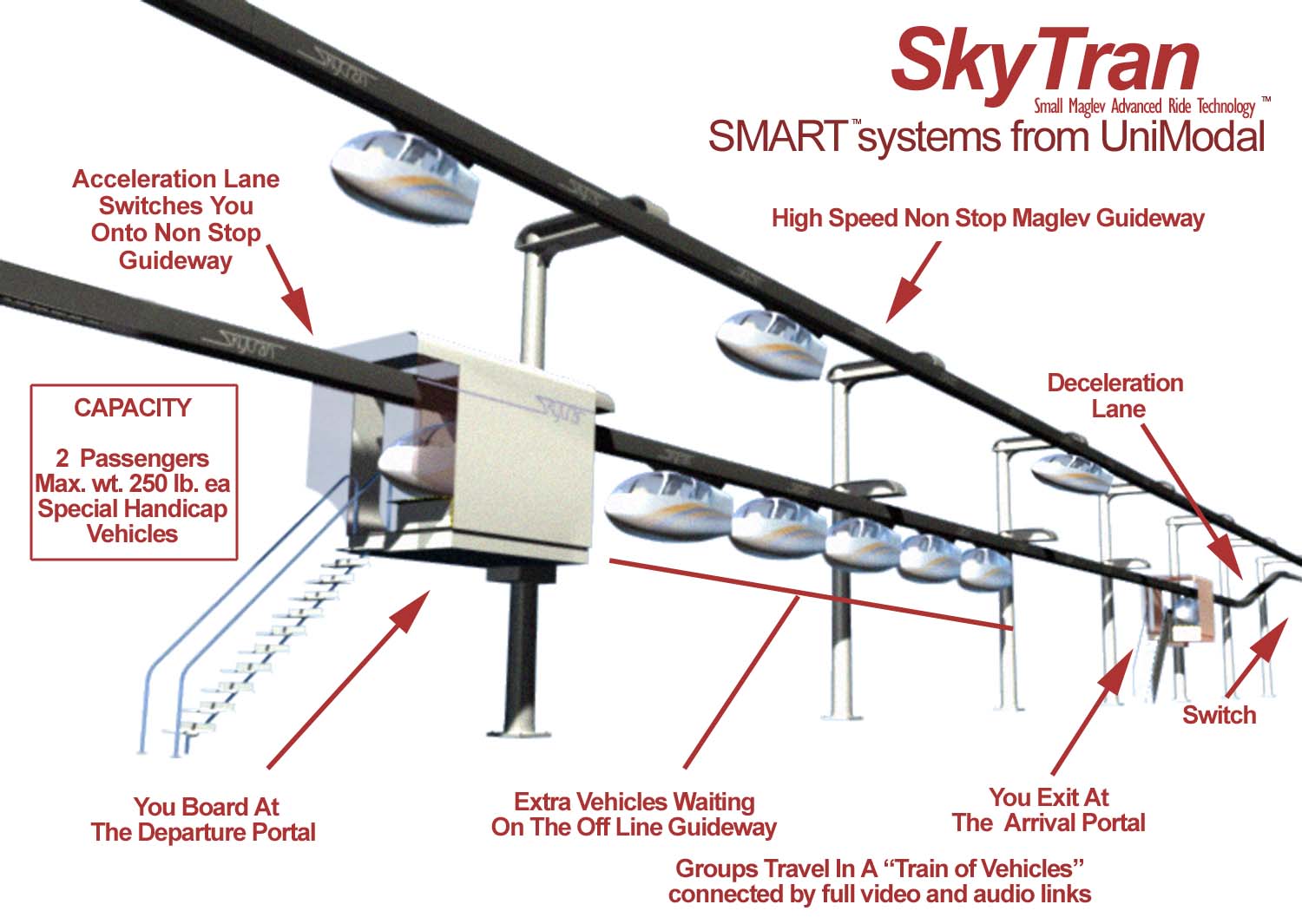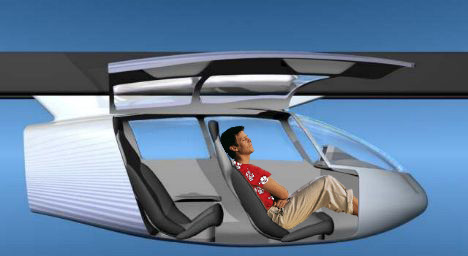The Economics of SkyTran in San Francisco
SkyTran is a type of mass transit called Personal Rapid Transit or PRT. A PRT system has vehicles that can be taken on demand (meaning no waiting), and can transport people anywhere in the system. This is very similar to the road system because one can get in a car when they want to, and travel where they want to. SkyTran is currently being developed by Unimodal Inc.
SkyTran is a simple and light-weight design, the guideway's supports can be made using standard utility poles in a similar way to street lights. Vehicles are levitated using a maglev design called Inductrack. Inductrack employs a series of unpowered insulated conductors inside the guideway and permentant magnets inside the vehicles - no complicated electronics are needed to levitate vehicles. As a vehicle moves over the insulated conductors in the guideway, part of the vehicle's forward momentum is converted to an upward force that levitates the vehicle. This allows for a very simple design of both the guideway and vehicles. The only electronics needed are a linear induction motor to propel vehicles and control electronics to direct the vehicles. The system can also use a regenerative braking system. Inside the vehicle is a cabin with two seats, a door, and a small computer. Compared to a modern gasoline car, SkyTran's vehicles contain thousands fewer parts - even the guideway has fewer fabrication steps than an inner city road.
SkyTran would ideally be built as a grid-system so that anyone could go anywhere on the grid. However, the system can also be built linearly like a train route.
This report predicts how a SkyTran system would economically affect the city of San Francisco. Needless to say, I would not have written this report if the predictions weren't interesting - in fact, my calculations show unprecedented benefit. You may have seen the movie Who Killed the Electric Car, and seen how extremely efficient electric cars can be built and thrive in the market place. While electric cars can be much more reliable and inexpensive than combustion-engine cars, electric cars can never solve the problem of road congestion and traffic. Roads and cars simply take up too much space. This report shows that SkyTran can solve this seemingly difficult problem while doing what the free market is meant to do best: making people money.
SkyTran in San Francisco
The hypothetical grid system that could be built in San Francisco has unprecedented predictions. The first predictions are "bare bones" predictions, which don't take any complicated statistics or effects into account. They simply look at 1. building cost, 2. running cost, and 3. revenue. The most notable thing about the predictions is that SkyTran would actually make money. This seems trivial, but no other large-scale transportation system has ever accomplished this without heavy government subsidies. The second most notable thing about the predictions is that the system would pay off in less than 6 and a half years if charging the suggested 10 cents per mile. After this, it would make almost $32 million per year. Of course, charging prices around the price of riding BART or taxis would allow the system to pay off much faster - as much as 20 times faster (at taxi rates, the system would pay off in 2 months, assuming that the obscene price doesn't affect ridership...).
If you're not that interested in its benefits for the city as a whole, you might like to know how SkyTran could benefit you personally. Any average SkyTran user would save almost $500 per year - almost $15,000 after 30 years. However, an ex-driver would save more than $5500 per year, which is upwards of $160,000 after 30 years. Not to mention that these SkyTran users would save almost 250 hours or 10 days of their life per year - this is equivalent to more than 6 working weeks. On average, people waste 5% of their lives driving on the road - 18 full days per year. Imagine having an extra five waking-hours every week.
Right now, San Francisco uses more than $340 million per year on mass transit. SkyTran's running costs would be less than 15% of that figure - around $50 million. While this is a very small fraction of the current spending on mass transit, in addition SkyTran would be faster, more accessible, and would have more possible destinations than the current mass transit system in San Francisco. After considering the money saved on mass transit and other savings, SkyTran would provide more than $350 million of benefit per year and pay off in less than 7 months. In addition to this, San Francisco would have less use for large roads, and could sell a large amount of road space for other uses. Inner city land is a premium, and if half of it were sold (leaving plenty of road-space for cars and transport), almost $10 billion of land could be unlocked and sold for city profit.
That was all public benefit - and similar effects would happen to the private sector. Ex-car users would save large amounts of money per year, and private parking lot owners could sell more than $6 billion of parking lot space. After 30 years of this system, at the same ridership, the city as a whole (public and private) would have incurred $28 billion of benefit - a staggering 13,700% return to investment. Keep in mind that a system like this maintaining a constant ridership is highly unlikely - it is much more realistic that more and more people would use the system as time went on - increasing profit and total benefit and making this incredible return to investment an underestimate.
The system provides more than just monetary benefit. It also would save more than 21 million man-hours per year - enough to build 3 Empire State buildings. The Golden Gate bridge was built by 25 million man-hours, and the Empire State building was built by 7 million man-hours.
One might disbelieve the estimated $1 million per mile, and that's fine. If SkyTran instead cost 10 times as much ($10 million per mile) the benefit drops from $28 billion to $27 billion after 30 years. The reason for this is that SkyTran's benefit lies in its operating costs - not its upfront cost. SkyTran can save the money we spend on gasoline, roads, repairs, insurance, and countless other things.
Other effects of a SkyTran grid-system
One large effect of a SkyTran grid-system is that car-related spending would rapidly decrease. This would most likely cause economic trauma in all sectors dealing with cars, and job losses to match. About 30% of retail spending is on cars, and a rapid change in such a large market would be devastating to those areas. The devastating effects on sectors serving the needs of automobiles will produce a barrage of political resistance, since this sector of the economy is controlled by powerful interests.
Local pollution would also greatly decrease. Automobiles generate about 60% of all harmful emissions, and SkyTran would decrease the use of cars by a significant percent - perhaps reducing emissions by 20% or 30%.
If the system were much larger (say extending throughout California), it would usher in an age of unprecedented mobility and transform the climate of the transportation industry. One effect is that gas prices would go down because of decreased demand. This probably wouldn't happen right away, because gas prices are more determined on the supply side - but oil prices would drop. A more important change would be that people could commute and travel farther. If SkyTran was built in a grid system throughout California more than 1/2 of the entire state could commute to San Francisco (in less than an hour and a half). This would have profound effects on the employment situation in the US, allowing people to take jobs that wouldn't previously be feasible.
A more obscure but significant effect of a large grid system is reducing airport gridlock. Billions of dollars are spent yearly to solve airport gridlock problems, and those billions could be saved if the SkyTran system covered more than 300 miles surrounding an airport. Airports could focus on longer distance flights, and could use space previously used for car parking to expand the airport.
Conclusions
SkyTran is a unique PRT design that has obvious advantages and could provide enormous benefit to any area that built the system. The monetary benefits alone of this system would be incentive for any private investor to support this system, but the benefit the system could provide for its users would overshadow any profit. The time and money saved by using SkyTran over a car would drastically improve the quality of life of its users. The automobile industry should jump at adopting this new system - and gain some of the profit themselves - rather than fighting it. Transportation has come to a crossroads, and Personal Rapid Transit seems like an inevitable advance in transportation technology that will take us where we've always hoped we could go.
Calculations:
The following spreadsheet outlines every assumption and calculation I used in the above summary. The calculations are written like a receipt, adding up benefits and costs to yield the overall benefit to the city and its people. Note that the excel file is much more up to date than this page is.
Download the spreadsheet: SF SkyTran report calculations and assumptions may 2008.xls
The "underestimates" written at the bottom of each list of figures and calculations in the spreadsheet are meant to detriment the system. This means that almost every figure you see in the spreadsheet is not ideally efficient. The calculations are done in such a way to show that these predictions are not idealized and are realistic predictions of what would happen. The lists of "underestimates" are there to tabulate exactly how the predictions are non-ideal.
Sources:
- www.gettherefast.org
- www.skyloop.org
- Broken link and not findable: http://higherway.artwerkz.com/index.shtml
- http://faculty.washington.edu/~jbs/itrans/PRT
- http://www.bicycle.sfgov.org/site/dpt_index.asp?id=13454
- Identical document: http://www.ci.sf.ca.us/site/dpt_index.asp?id=13454
- http://www.ce.umn.edu/~levinson/
- especially: http://www.ce.umn.edu/~levinson/Projects/HSR/HSR.html
- http://www.personal.psu.edu/users/e/m/emd5005/activitytwo.htm
- http://www.paralumun.com/triviabuildings.htm
- Google chached as: http://64.233.161.104/search?q=cache:HMrFopm9caIJ:www.paralumun.com/triviabuildings.htm+%22man+hours%22+to+build+world+trade+center&hl=en&client=opera
- http://www.frommers.com/destinations/newyorkcity/A24015.html
- Google cached as:http://64.233.161.104/search?q=cache:uYYzfY4EolQJ:www.frommers.com/destinations/newyorkcity/A24015.html+%22man+hours%22+to+build+world+trade+center&hl=en&client=opera
- http://www.eia.doe.gov/cneaf/electricity/epa/epat7p4.html
- http://www.spur.org/documents/050901_article_02.shtm
- http://www.computertelephony.org/blog/index.php?p=47
- http://www.zmag.org/content/showarticle.cfm?SectionID=56&ItemID=5425
- Google cached as: http://64.233.161.104/search?q=cache:LZxOZCa2eLoJ:www.zmag.org/content/showarticle.cfm%3FSectionID%3D56%26ItemID%3D5425+%22car+related+spending%22&hl=en&client=opera
- http://216.239.57.104/search?q=cache:lzR-2DPxpD8J:www.ntdprogram.com/ntd/Profiles.nsf/1999%2B30%2BLargest%2BAgencies/9015/%24File/P9015.pdf+san+francisco+muni+revenues&hl=en&ie=UTF-8
- http://www.sfmuni.com/rid/pr/geninfo.htm
- http://www.bart.gov/about/reports/indicators.asp
- http://www.electric-bikes.com/bart.htm
- Broken link and not findable: http://216.239.57.104/search?q=cache:vm_xw-nehWYJ:www.transcoalition.org/reports/revt/brtplan_sf.html+cost+of+traffic+enforcement+in+san+francisco+costs&hl=en&ie=UTF-8
- Broken link and not findable: http://www.carlburton.com/TranNov2202.htm


